Pas toujours facile de connaître les besoins nutritionnels de bébé et de démarrer la diversification alimentaire ou la DME. Alors pour vous aider dans les repas de bébé, nous avons élaboré ce tableau de repas/menus types pour vos bébés de 4 mois, 6 mois, 8 mois, 12 mois et plus. Les âges indiqués sont en mois révolus.
Ce sont des quantités données à titre indicatif (sauf pour les protéines et matières grasses où il faut respecter la dose journalière) et vous pourrez moduler les aliments sur la journée comme bon vous semble.
Aujourd’hui, les recommandations nutritionnelles indiquent qu’il n’y a pas d’ordre particulier à respecter pour introduire les différents groupes d’aliments entre 4 et 6 mois : légumes, fruits, volaille, poisson, viande, œufs, légumes secs (lentilles, haricots, pois chiches…), féculents (pâtes, riz, semoule), produits laitiers… Vous trouvez que cela fait beaucoup ? Rassurez-vous, cela ne signifie pas que vous devez impérativement tout donner d’un coup ! Vous adapterez les portions en fonction de votre enfant, de sa morphologie, de son appétit, de son activité physique… Rappelez-vous que chaque enfant est unique 🥰
Pensez à proposer de l’eau au cours de la journée et lors des repas lorsque l’enfant est diversifié. Pas d’ajout de sel et de sucre dans les préparations.
Jusqu’à 12 mois, le lait reste l’aliment principal pour bébé qui doit prendre 500 ml minimum par jour.
Téléchargez le tableau en format pdf ici
Repas bébé 4 mois / 5 mois ou début de diversification
| Petit-déjeuner | Laitages : lait maternel ou 150 à 180 ml de lait 1er âge Céréales : plus ou moins 1 à 2 cuillères à café de céréales infantiles* |
| Déjeuner | Légumes cuits : en diversification quelques cuillères (ou directement dans le biberon) Laitages : lait maternel ou 150 à 180 ml de lait 1er âge |
| Goûter | Laitages : lait maternel ou 150 à 180 ml de lait 1er âge Fruits : en diversification quelques cuillères (compote sans sucre ajouté (maison ou petit pot)) ou fruit cuit |
| Dîner | Laitages : lait maternel ou 150 à 180 ml de lait 1er âge + 1 collation dans la journée (lait maternel ou 5ème biberon de 150 à 180 ml de lait 1er âge) |
Alimentation bébé 4 mois / Repas bébé 4 mois – Alimentation bébé 5 mois / Repas bébé 5 mois
Repas bébé 6 mois / 7 mois
| Petit-déjeuner | Laitages : lait maternel ou 180 à 210 ml de lait 2ème âge Céréales : plus ou moins 2 à 3 cuillères à café de céréales infantiles* |
| Déjeuner | Légumes cuits : 100 g maison ou repas industriel infantile Féculents cuits : 30 g de pommes de terre, semoule, petites pâtes, riz, légumes secs Viande, poisson, œuf : 10 g soit 1/6 d’œuf Matières grasses : 5 à 10 g (1 à 2 cuillères à café) Fruits : 50 à 100 g (compote sans sucre ajouté (maison ou petit pot)) ou fruit cuit |
| Goûter | Laitages : lait maternel ou 180 à 210 ml de lait 2ème âge Fruits : 50 à 100 g (compote sans sucre ajouté (maison ou petit pot)) ou fruit cuit |
| Dîner | Laitages : lait maternel ou 180 à 210 ml de lait 2ème âge + 1 collation dans la journée (lait maternel ou 4ème biberon de 180 à 210 ml de lait 2ème âge) |
Alimentation bébé 6 mois / Repas bébé 6 mois – Alimentation bébé 7 mois / Repas bébé 7 mois
Repas type 8 mois / 9 mois
| Petit-déjeuner | Laitages : lait maternel ou 210 à 240 ml de lait 2ème âge Céréales : plus ou moins 2 à 3 cuillères à café de céréales infantiles |
| Déjeuner | Légumes cuits : 100 à 120 g maison ou repas industriel infantile Féculents cuits : 40 à 50 g de pommes de terre, semoule, petites pâtes, riz, légumes secs Viande, poisson, œuf : 10 à 15 g Matières grasses : 10 g (2 cuillères à café) Fruits : 100 g (compote sans sucre ajouté (maison ou petit pot)) ou fruit cuit |
| Goûter | Laitages : lait maternel ou 210 à 240 ml de lait 2ème âge Fruits : 100 g (compote sans sucre ajouté (maison ou petit pot)) ou fruit cuit |
| Dîner | Légumes cuits : 100 à 120 g maison ou repas industriel infantile Féculents cuits : 40 à 50 g de pommes de terre, semoule, petites pâtes, riz, légumes secs Matières grasses : 10 g (2 cuillères à café) Laitages : lait maternel ou 120 à 150 ml de lait 2ème âge |
Repas type bébé 10 mois / 12 mois
| Petit-déjeuner | Laitages : lait maternel ou 250 ml de lait 2ème âge Céréales : plus ou moins 2 à 3 cuillères à café de céréales infantiles |
| Déjeuner | Légumes cuits : 120 à 150 g maison ou repas industriel infantile Féculents cuits : 50 à 60 g de pommes de terre, semoule, petites pâtes, riz, légumes secs Viande, poisson, œuf : 15 g soit 1/4 d’œuf Matières grasses : 10 g (2 cuillères à café) Fruits : 100 g (compote sans sucre ajouté (maison ou petit pot) ou fruit cuit |
| Goûter | Laitages : lait maternel ou 250 ml de lait 2ème âge Fruits : 100 g (compote sans sucre ajouté (maison ou petit pot)) ou fruit cuit |
| Dîner | Légumes cuits : 120 à 150 g maison ou repas industriel infantile Féculents cuits : 50 à 60 g de pommes de terre, semoule, petites pâtes, riz, légumes secs Matières grasses : 10 g (2 cuillères à café) Laitages : lait maternel ou lait 2ème âge ou 1/2 laitage nature au lait entier ou 10 à 20 g de fromage |
Menu type bébé 1 an / 2 ans
| Petit-déjeuner | Laitages : lait maternel ou 250 ml de lait de croissance nature Pain, céréales, biscuits : 1 tartine de pain (ou cracotte) avec beurre ou purée d’oléagineux* Fruits : plus ou moins 1 petit fruit (compote sans sucre ajouté (maison ou petit pot) ou fruit cuit |
| Déjeuner | Entrée : 20 à 30 g de crudités Légumes cuits : 90 à 110 g maison Féculents cuits : 60 à 80 g de pommes de terre, semoule, petites pâtes, riz, légumes secs Viande, poisson, œuf : 20 g Matières grasses : 10 g (2 cuillères à café) Fruits : 100 g (compote sans sucre ajouté (maison ou petit pot) ou fruit cuit Pain : plus ou moins 1 tranche de pain |
| Goûter | Laitages : Lait maternel ou 250 ml de lait de croissance nature ou 1 laitage nature au lait entier Fruits : 100 g (compote sans sucre ajouté (maison ou petit pot)) ou fruit cuit Pain, céréales, biscuits : 1 tartine de pain beurré ou 1 biscuit peu sucré |
| Dîner | Légumes cuits : 90 à 110 g maison Féculents cuits : 60 à 80 g de pommes de terre, semoule, petites pâtes, riz, légumes secs Matières grasses : 10 g (2 cuillères à café) Laitages : Lait maternel ou lait de croissance ou 1 laitage nature au lait entier ou 20 g de fromage |
Alimentation bébé 1 an / Repas bebe 1 an – Alimentation bébé 24 mois / Repas bebe 24 mois
Repas type bébé 2 ans / 3 ans
| Petit-déjeuner | Laitages : 250 ml de lait de croissance nature Pain, céréales, biscuits : 1 tartine de pain (ou cracotte) avec beurre ou purée d’oléagineux* Fruits : plus ou moins 1 petit fruit (compote sans sucre ajouté (maison ou petit pot) ou fruit cuit |
| Déjeuner | Entrée : 30 à 50 g de crudités Légumes cuits : 60 à 80 g maison Féculents cuits : 80 à 100 g de pommes de terre, semoule, petites pâtes, riz, légumes secs Viande, poisson, œuf : 30 g soit 1/2 d’œuf Matières grasses : 10 g (2 cuillères à café) Fruits : 100 g (compote sans sucre ajouté (maison ou petit pot)) ou fruit cuit Pain : plus ou moins 1 tranche de pain |
| Goûter | Laitages : 250 ml de lait de croissance nature ou 1 laitage nature au lait entier Fruits : 100 g (compote sans sucre ajouté (maison ou petit pot)) ou fruit cuit Pain, céréales, biscuits : 1 tartine de pain beurré ou 1 biscuit peu sucré |
| Dîner | Légumes cuits : 60 à 80 g maison Féculents cuits : 80 à 100 g de pommes de terre, semoule, petites pâtes, riz, légumes secs Matières grasses : 10 g (2 cuillères à café) Laitages : 1 laitage nature au lait entier ou 20 à 30 g de fromage |
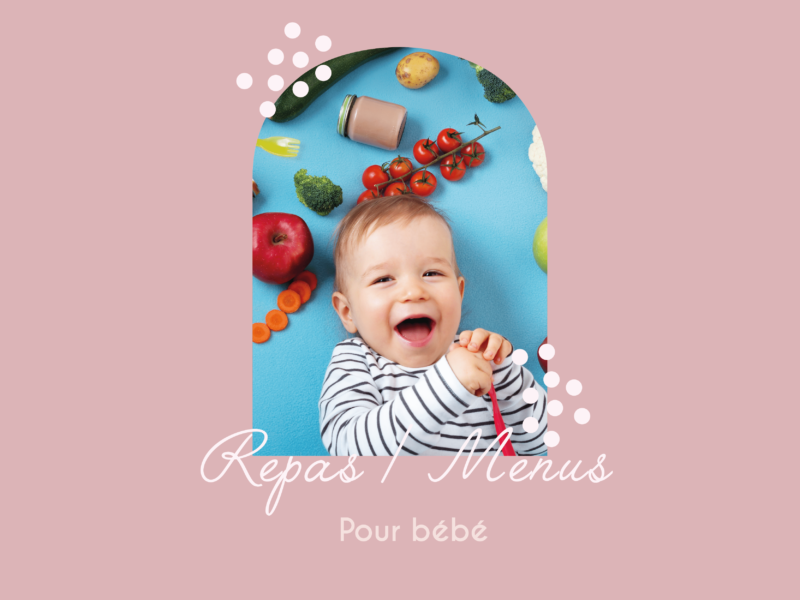



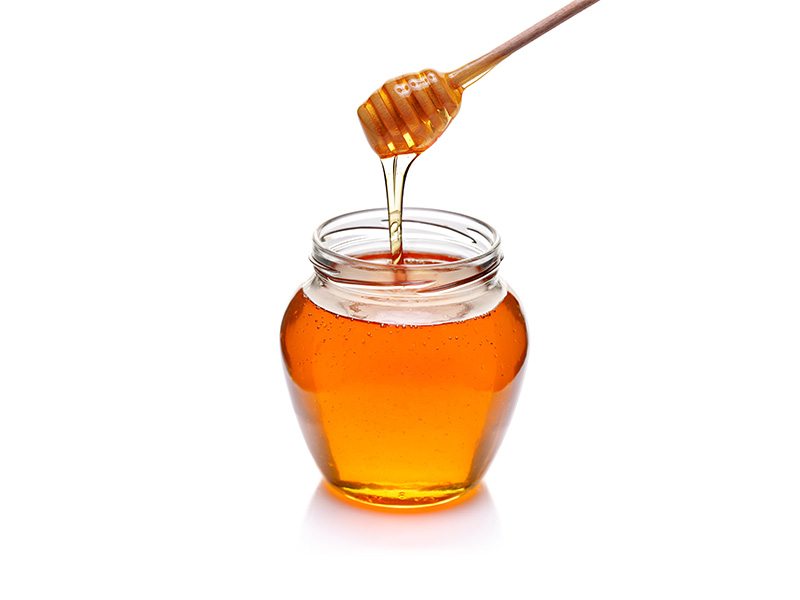
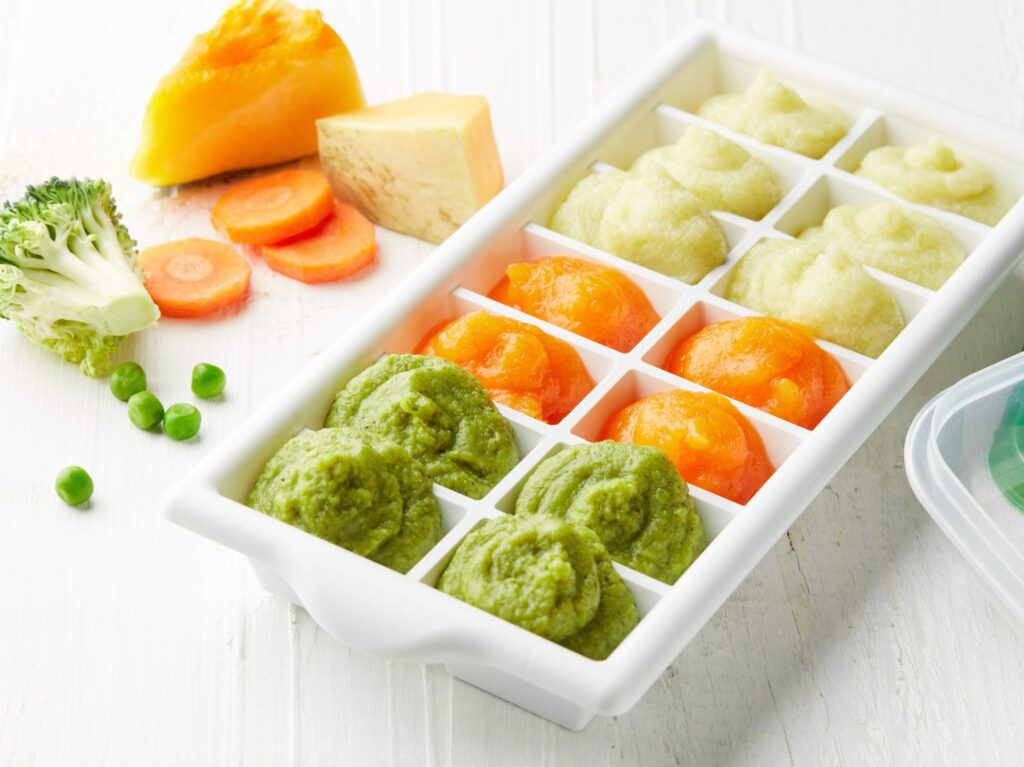
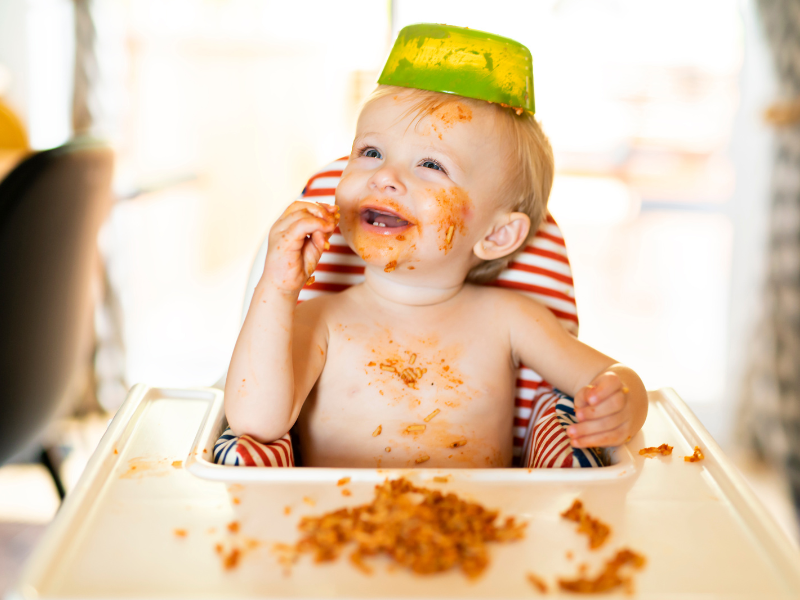
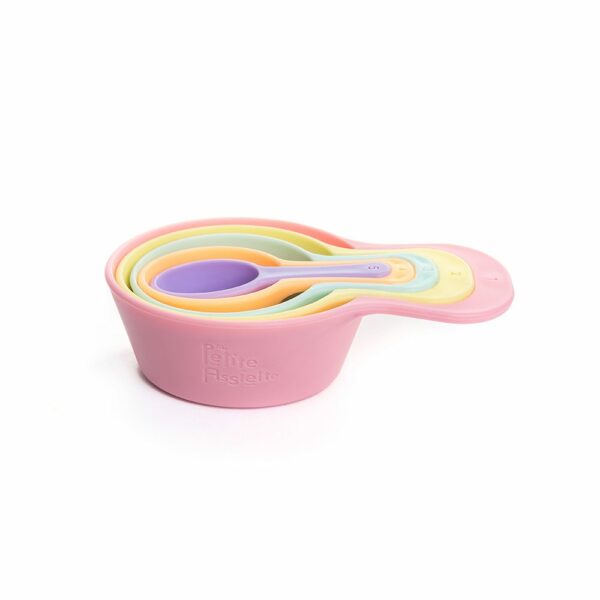
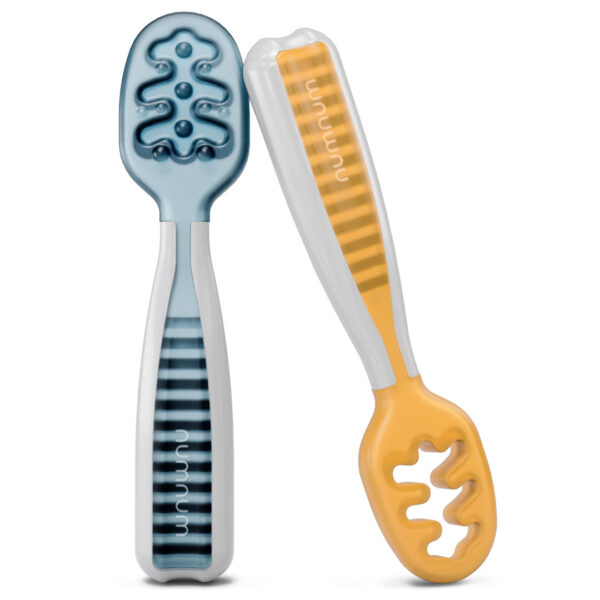

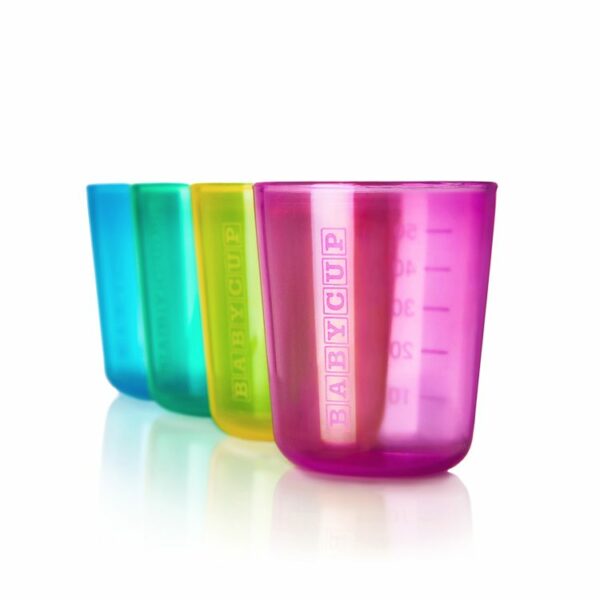
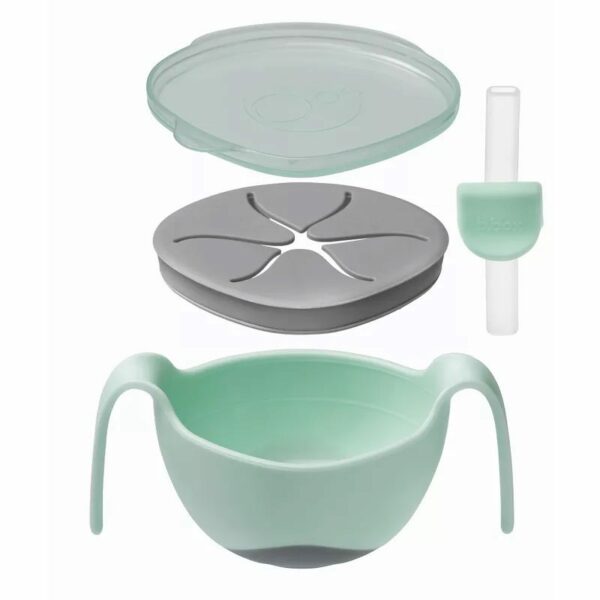
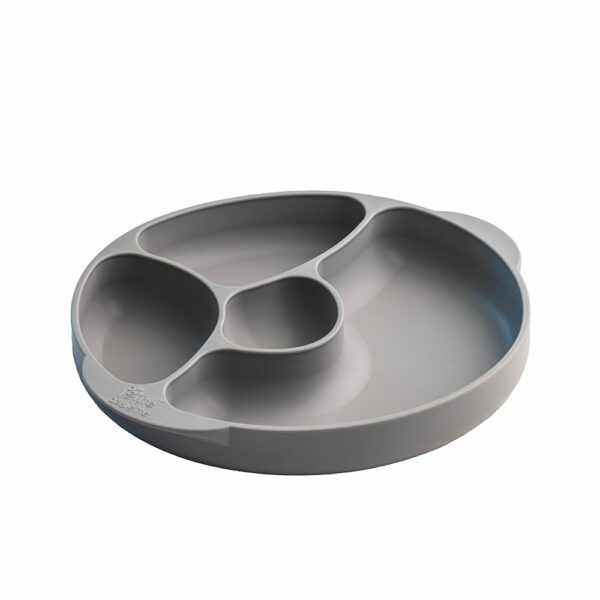
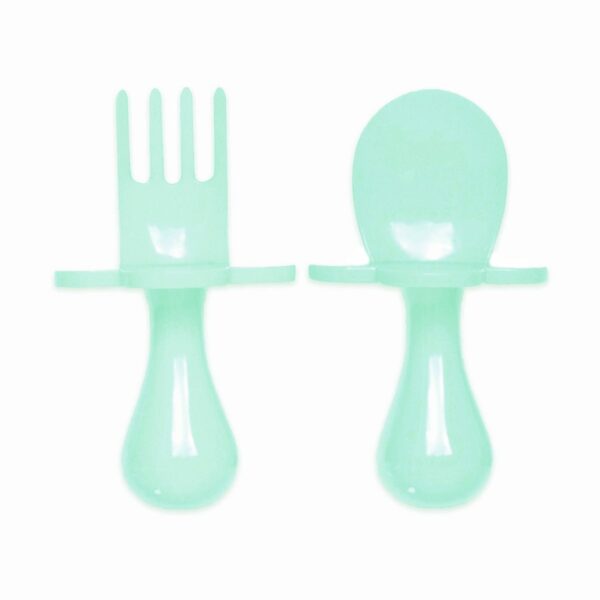
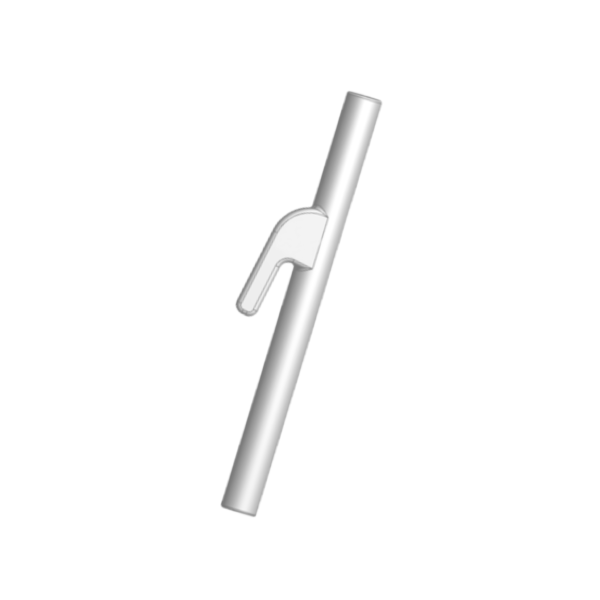
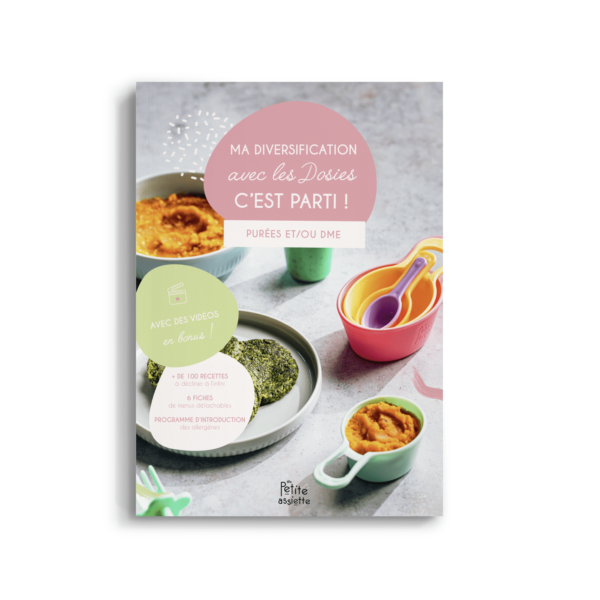
56 Commentaires. En écrire un nouveau
Bonjour,
J’ai téléchargé votre tableau des menus types et je vous remercie grandement pour votre partage d’informations qui rend la diversification un moment serein et agréable pour toute la famille
Une question concernant les laitages à partir de 6 mois. Vous ne parlez ni de tétées ni de produits type yaourt pour les repas du midi. Est ce une recommandation de ne plus du tout manger de produit laitier les midis?
Merci d’avance pour votre retour.
Bonjour,
Merci pour votre message.
Les tableaux sont donnés à titre indicatif afin de représenter l’équilibre alimentaire recommandé pour les bébés par âge, mais ils ne sont pas figés. Il n’y a aucune contre-indication à proposer un laitage à midi du moment que les 500ml de lait sont bien apportés dans la journée.
Bonjour, tout d’abord, merci pour toutes ces informations
Mon bébé a 3 mois, il a commencé sa diversification à 2 mois et une semaine dû à un RGO avec œsophagites à répétition malgré un traitement médicamenteux assez lourd. Je tiens à préciser que notre pédiatre à écarter au fur et à mesure, allergies, intolérances, hernie hietal, sténose, …. On lui a même donné du lait en poudre AR, lait de riz, épaississant de lait…. Bref bébé n’allait pas mieux.
Bébé est allaité au biberon avec épaississant (gumilk) avec au début de la diversification de la soupe (maison), plus épaisse que son lait épaissi, 5ml après chaque biberons (de 120ml à 150ml selon l’appétit de bébé) puis 10ml soit 50ml/ jours car 5 biberons.
Aujourd’hui il a 3 mois, nous avons commencé les purées lisses (maison légumes ou fruits) + 5 biberons (de 150ml à 180ml selon l’appétit de bébé)
1 cuillère à café sur ses 3 biberons de la journée soit 3 cc par jour, sachant que le biberon du matin et du soir ne sont pas suivi de purée car avec son médicament pour l’oesophage, ça épaissi donc plus besoin de purée pour éviter les remontées. Je donne la purée après le bibi pour éviter les remontées, ça fonctionne bien, bébé re-mange enfin et surtout avec le sourire et appétit.
Étant donné que mon loulou est encore petit, j’aimerais savoir :
Quels sont les fruits et légumes les plus digestes ?
Dois-je mettre des céréales dans son biberon de lait (maternel) le matin ou attendre ses 4 mois ?
A quelle fréquence augmenter la quantité de purée (je n’ai aucune idée si une cc par jour où par semaine donc j’aimerais une indication pour ne pas aller trop vite (pour ses organes), bien évidemment bébé mange ce qu’il veut il n’est pas forcé, sachant que depuis la diversification, il n’a plus de problème de constipation (à cause des médicaments) et qu’il digère mieux ?
Désolée pour ce long texte mais je tenais à ce que vous ayez le plus d’éléments possible pour m’éclairer au mieux. Et encore merci pour votre travail. Bonne journée
Bonjour Laetitia, et merci pour la confiance que vous nous accordez. Malheureusement il est pour nous difficile de répondre à toutes vos questions concernant la santé de bébé avec le peu d’information que nous avons là. Le mieux que l’on puisse vous conseiller sera de consulter un gastro pédiatre ou une diététicienne pédiatrique qui grâce à une consultation pourra vous aider davantage.
Vous pourrez contacter Tiffany Deroyer, diététicienne pédiatrique (https://www.tiffany-deroyer.fr/) pour plus de renseignements au sujet de votre enfant, un accompagnement vous permettra de prendre en charge l’alimentation de bébé dans sa globalité et cela pourra également vous rassurer. En espérant que cela puisse vous aider, toute l’équipe Ma Petite Assiette vous souhaite une très belle journée 🙂
Bonjour,
Je ne vois rien du tout à propos des légumineuses dans votre tableau. Ça pourrait être intéressant de les inclure aussi pour les végétariens ou les parents qui ne veulent pas forcément donner de la viande et du poisson tous les jours. Car il est tout à fait possible de le faire ! Ça demande juste un petit plus de préparation pour les rendre plus digestible (je fais un trempage de 48h avec 2e 24h rinçage 3 fois, d’ailleurs il est aussi recommandé de tremper les céréales et graines et fruits secs en général pour se débarrasser de l’acide physique présent dans l’enveloppe et dans les peaux qui empêche l’absorption des vitamines et nutriments). Les lentilles corail et haricot aduki peuvent être consommé tel quel, par contre les plus gros haricots et pois chiche il faut enlever la peau pour éviter trop de fibres jusqu’à 1 an. Ici au Portugal (et soit dit en passant la diversification diffère, donc moi j’ai fait un peu comme ci et un peu comme ça), l’introduction des légumineuses ne se fait pas avant 9 mois mais dans le cadre d’un régime végétarien (pas suivi par ma pédiatre car ils n’ont aucune connaissance de ça et sont même en général, pas elle, réfractaires), il ait possible de les introduire avant notamment lentilles coral et aduki.
Juste pour info, autres différences ici: ils préconisent 30g de protéines animales (j’ai halluciné, mais ce sont des gros mangeurs de viande et poisson ici); pas de betterave, épinards, céleri et navet avant 1 an à cause de leur haute teneur en nitrates et acide phytique (bon ma fille je lui en donne un peu); les farines c’est pas dans le biberon et surtout pas le soir mais en bouillie cuite le matin (moi j’ajoute toujours un fruit et un fruit séché type figue, abricot, datte, et un beurre de fruits secs genre amande ou cacahuète plus un peu de graines de lin moulues pour les omegas 3, et je varie énormément le type de céréales et de fruits, etc, elle adore !).
Voilà, et je ne sais pas ce qu’il en ait en France mais j’ai appris ici qu’il est mieux de complémenter en fer tous les bébés jusqu’à un an et ce quelque soit leur régime. À bon entendeur !
Bonjour,
J’ai téléchargé votre tableau quand mon petit à commencer la diversification en avril. Sur celui ci il est écrit des fruits des 6 mois à chaque déjeuner. Or là je ne le vois plus. S’agissait il d’une erreur ? Il adore sa compote le midi je crains les crises de larmes si je l’arrête mais je ne voudrais pas lui donner trop… merci pour ce tableau sinon c’est très pratique!
Bonjour,
Nous avons fait quelques mises à jour. Il s’agit uniquement de repères et quantités indicatives. Donc si bébé aime sa compote, on garde sa compote 🙂 Il y a peu de risque de trop en donner… Sachant tout de même que le lait maternel/infantile reste l’aliment principal jusqu’à 12 mois.
Belle journée
Bonjour,
Les recommandations de l’ANSES sur manger-bouger (le fascicule téléchargeable) ne sont pas les mêmes.
Elles dates de 2015 et seront apparemment bientôt rééditer, est ce que vos recommandations sont celles qui devraient être publiées ?
Merci
Alice
Bonjour,
Les recommandations sont celles de nos médecins nutritionnistes et diététiciennes pédiatriques en lien avec celles officielles.
bonjour,
Comme d’habitude, c’est très précis. Par contre, je ne comprends pas pourquoi le tableau fournit dans les dosies ne correspond pas à celui là?
par exemple, dans les dosies, pour 6 mois, c est 125 g de légumes +80 g de féculents… ici : 100g de légumes+30g de féculents?
Pouvez-vous m’éclairer?
merci d’avance
audrey
Bonsoir,
Merci pour votre message. Tout d’abord les ml ne correspondent pas aux équivalents en grammes et certaines purées seront plus « lourdes » que d’autres.
Par ailleurs, dans le guide des Dosies nous parlons uniquement des repas du déjeuner et dîner, sur le tableau, il est noté une présence de féculents au petit-déjeuner également (avec les céréales infantiles) qui viendront compléter ceux du déjeuner. Il conviendra donc d’adapter la dose sur la journée entière. Sachant qu’il n’y a pas de risque de surdosage de légumes ou de féculents.
Bonne soirée 😉
Bonjour, mon bébé a commencé la diversification à 5 mois à cause de son RGO.
Il va avoir 6 mois le 2 janvier… Je vais donc commencer la viande.
Actuellement il mange 120 grammes de purée le midi et 80 grammes de compote au goûter avec tétée en priorité.
Ma question est dois je lui donner de l’eau ? Il est allaité ou lui proposer du lait après le repas de midi est suffisant sachant que le lait maternel est composé à 80% d’eau
Puis une chose m’interpelle, vous notez dans le tableau 6/7 mois 100gr de fruit midi et 100gr au goûter… C’est pas de trop 200 grammes pour une journée ? Ce n’est pas plutôt 50 grammes midi et 50 grammes goûter ?
Bonjour,
Normalement l’allaitement lui apporte l’hydratation dont il a besoin, mais vous pouvez lui proposer 200 à 250 ml d’eau à disposition dans un verre s’il en éprouve le besoin.
Et non, ce n’est pas trop concernant les fruits… Ce sont des quantités indicatives, il faut s’adapter à bébé. Certains mangeront plus et d’autres moins 🙂
Bonjour, j’ai découvert votre site grâce à la Maison des Maternelles et Audrey de l’agence Happy Mum and Baby, et j’en suis ravie !
J’ai trois petites questions à vous poser: concernant les yaourts, est-il indispensable de choisir des yaourts spécifiques au lait infantile, ou des yaourts natures classiques au lait de vache (ou autre) peuvent être donnés à bébé ? Mon fils à 7 mois et demi, j’ai commencé à lui donner soupe/purée avec un peu de féculents le soir (conseillé par ma pédiatre), mais il a tendance à bouder le biberon de lait. Je compense par un yaourt au lait infantile. J’ai bien noté qu’il lui fallait 500ml de lait, je suppose qu’on peut pallier le lait par les autres laitages. Mais concernant l’eau, puisqu’il boit moins de biberon, quelle est la quantité d’eau recommandée sur une journée ?
Enfin, concernant les féculents, quelle doit être la cuisson? Fondante pour pouvoir mixer?
Excusez-moi pour ce pavé…. Merci par avance du temps que vous m’accorderez. Élodie
Bonjour,
Merci pour votre message. Vous avez plusieurs articles répondant à vos questions sur le blog et sur la FAQ (https://mapetiteassiette.com/faq/)
Pour les yaourts, ceux au lait infantile sont intéressants si bébé ne prend pas ses 500 ml de lait, sinon un yaourt au lait entier peut suffire.
Concernant l’eau, vous pouvez rajouter 200 à 250 ml d’eau par jour si bébé demande.
Pour les féculents, tout dépend de la capacité de bébé à manger les morceaux, mais le plus fondant possible au départ pour éviter les risques d’étouffement.
Belle journée
Bonjour,
C’est génial, ce tableau donne une bonne indication. J’ai par contre une question concernant le 1/2 yaourt. Mon fils va avoir 9 mois et je voulais savoir à quelque quantité en doses cela correspond-t-il ? Et s’agit-il uniquement de yaourt nature ou est-ce que cela peut-être des yaourts aux fruits aussi ?
Merci pour votre réponse 😉
Bonjour,
Merci beaucoup pour votre message. 1/2 yaourt correspond à environ 60/70 gr mais ça peut être plus ou moins en fonction de l’appétit de bébé.
Avant un an (et même après) il est conseillé de ne pas donner de sucres ajoutés, il vaut donc mieux le donner nature. Mais vous pouvez rajouter un peu de compote sans sucres ajoutés dedans pour donner plus de goût 🙂
Bonjour,
J’ai acheté les dosies et suis venu regarder les quantités journalières recommandées. Il me semble qu’entre ce tableau et celui des dosies cela ne correspond pas. pouvez vous m’éclairer davantage s’il vous plait.
En effet il me semblait bizarre qu’on donne exactement la même quantité de légumes et féculents à chaque repas à 6 mois qu’à 12 mois qu’à 18 mois (ce qui semble être le cas sur le tableau des dosies) alors que ce n’est pas ce qui apparait sur ce post.
Merci pour vos informations complémentaires, comme beaucoup de parents, je me pose beaucoup de questions sur cette étape merveilleuse de la diversification alimentaire.
Bonjour,
Merci pour votre message.
Le tableau a été effectué par les médecins/nutritionnistes et spécialistes qui ont également élaboré le guide des Dosies.
La différence entre 6 mois et 12 mois viendra de la texture. En effet à 6 mois, vous allez mixer les légumes (féculents) avec de l’eau ou du lait pour rendre la texture plus lisse, ce qui fera au final moins d’aliments solides, alors qu’à 12 mois vous remplirez la Dosies de l’aliment « brut ».
Comme nous le répétons partout (sur ce tableau, comme sur le guide des Dosies) ce sont des quantités à titre indicatif, chaque bébé est unique et mangera plus ou moins. Il n’y a aucun risque à manger plus ou moins de légumes ou féculents. Les familles d’aliments auxquelles il faut être vigilant sont les matières grasses et les protéines, car des sous ou sur-dosage pourraient être dangereux. Pour le reste, il faut écouter bébé et s’écouter…
En espérant avoir répondu à vos questions 🙂
Belle journée
[…] indication sur les quantités à donner à bébé en cliquant ici. […]
Merci pour votre travail!
J’ai une bébé de 5 mois. Les fruits, comment les lui donner? En jus ou bien cuits?
Bonjour,
Merci beaucoup ! En général on commence par des fruits cuits qui sont plus digestes. Et un à la fois 🙂
Belle journée
Bonjour j ai pris connaissance de votre tableau qui est tres interressant mon bebe viens d avoir 6 mois il prend des puree de legumes a la cuillere le midi jai commencer aussi a introduire les yaourte a midi il prend une compote maison au gouter et je viens de commencer la semoule de ble dans le biberon du soir..la question que je me pose c est qu il continue a reclamer des biberon de lait a midi car il se reveille assez tot 5h/5h30 est ce un pb dois obligatoirement suprimer ce biberon
Bonjour,
A 6 mois le lait reste la base de l’alimentation de bébé à raison de 500 ml par jour. Il est donc primordial de ne pas le supprimer. Le reste est là pour découvrir de nouvelles saveurs et textures. Donc si bébé réclame le biberon, donnez-lui 🙂
Bonjour,
Mon enfants à 7 mois. Quand je regarde votre tableau de repas, j’ai du mal a mis retrouver.
Le midi je lui donne environ 150 gr de purée maison avec pomme de terre inclus. 10 gr de viande mais pas forcément à chaque repas. plus un biberon de 120 ml
au goûter 1 yaourt classique et 1 petit pot de 130 gr de compote
Le soir 1 biberon de 210 ml avec farine du soir au goût légumes
dois je intégrer un repas le soir?
Je vois que vous donner 1 fruit le midi et le soir, est ce obligatoire?
Je pensais que les fruits étaient à exclure le soir car riche en vitamines.
Merci
Bonjour,
Comme précisé, il s’agit de quantités à titre indicatif qu’il faudra adapter en fonction de bébé et de son évolution. Jusqu’à 12 mois, le lait reste la base de son alimentation à raison de 500 ml par jour.
Si vous sentez que votre enfant est calé pour l’instant avec le biberon, alors vous pouvez attendre pour lui proposer un repas du soir. Et essayer vers 8/9 mois en fonction de ses envies.
Encore une fois c’est le lait qui est primordial à son alimentation.
Pour les fruits, une portion par jour peut suffire à son âge, mais il n’y a pas de contre indication à lui en donner le soir (cuit ou en compote pour l’instant).
Bonne journée 🙂
Bonjour,
Mon fils a bientôt 6 mois. il refuse de manger des fruits. j’ai essayer tout les moyens, cuit, cru mais il refuse toujours.. comment puis-je lui faire aimer les fruits? une grignoteuse (tétine à fruit) est-ce bon aussi? merci
Bonjour,
Oui la grignoteuse peut être une bonne option. Vous pouvez essayer d’en mélanger dans le biberon aussi pour l’habituer au goût. Il faut lui représenter régulièrement, il y goûtera quand il sera prêt, pas d’inquiétude 😉
Bonjour mon bébé va avoir 6 mois il est allergique a la protéine de lait de vache.. Depuis mai te at 2 mois he lui donne un petit pot le midi avec un biberon de 120g et le soir un petit pot et biberon de 150g.. Je voulais savoir si je peu lui donner un goûter compote et combien de lait ??? Et également je voulais savoir si le soir je dois augmenter la quantité de lait ???
Merci pour votre retour
Bonjour,
A 6 mois votre enfant a besoin de 500 ml de lait par jour minimum, il suffit de les répartir sur la journée en fonction de ses envies 😉
Mon bébé de six mois fait ses dents et ne veut plus prendre ses biberons carly j’ai pas encore commencé la diversification. Que. Dois je faire pour qu’il s’alimente?
Bonjour,
Il faut en parler avec votre médecin/pédiatre pour voir si vous pouvez lui donner d’autres choses comme des yaourts au lait infantile par exemple pour compenser…
Bonjour, ma fille de presque 7 mois boit de plus en plus difficilement ses biberons de lait. A coté elle mange très bien ses petits pots( le midi un pot de purée+ un yaourt au lait infantile et un pot de compote au goûter). Comment lui faire prendre ses 500ml de lait? céréales? mettre un peu de purée dans le biberon du soir? lui donner plus en yaourt? Merci de votre réponse. J’ai par ailleurs acheté votre livre depuis peu et il aide bien pour se rassurer sur ce que l’on peut faire pour la diversification!
Bonjour,
Merci pour votre message !
Si elle ne prend pas le lait vous pouvez effectivement substituer par des yaourts au lait infantile (1 yaourt de 125 g = 150 ml de lait environ), pour qu’elle atteigne le « quota » ;).
Vous pouvez également mettre un peu de purée dans le biberon du soir, si elle aime le goût des légumes, cela permettra aussi de lui faire prendre du lait.
Bonne journée 🙂
Bonjour,
Mon deuxième petit garçon de 6mois maintenant refuse les purées ou compotes.
Je fais tout maison, j’essaie de varier les goûts mais rien à faire…
Il ne boit qu’un biberon de soupe le soir…
Pouvez-vous m’aider svp?
Bonjour,
Jusqu’aux 12 mois de bébé, l’aliment principal reste le lait (maternel ou infantile), 500 ml minimum par jour. Il couvre 70% des besoins nutritionnels. La diversification est là uniquement pour lui faire découvrir des nouvelles saveurs et textures. Donc pas d’inquiétude.
Continuez de lui proposer des aliments régulièrement. Il faut en moyenne 7 à 8 représentations pour qu’un aliment soit accepté… Il n’est peut-être pas encore prêt. Ca viendra ! 🙂
Bonjour, je viens de regarder le tableau et la fille de 8 mois est loin de manger ce qui est indiqué. Le matin c’est 250ml de lait maternel, à midi entre 150 et 200gr de petit pot maison et 1 yaourt au goûter, à peu près 100gr répartit entre compote et yaourt et le soir 250ml de lait maternel. Est ce juste un petit appétit ou qu’il faut qu’on lui propose autre chose ? Je dis ça aussi car depuis 1 semaine elle se réveille à 4h du matin pour boire et ne réclame rien avant la fin de la matinée 11h/12h. Faut il lui proposer des légumes le soir ?
Bonjour,
Ce tableau a été élaboré avec nos spécialistes et médecin nutritionniste à titre indicatif.
Chaque enfant est unique et a son propre rythme. Jusqu’aux 12 mois de l’enfant, le lait couvre 70% de ses besoins nutritionnels (minimum 500 ml par jour). Donc pas de panique ! 😉
Si votre fille se réveille dans la nuit, il est peut-être temps de lui proposer des légumes le soir effectivement, avec pourquoi pas un peu de féculents pour la « caler ». Sans oublier le biberon de lait 😉
Bonjour, ma fille a 6 mois et demi, j’ai commencé la diversification à 4 mois. A partir de quand dois-je intégrer un repas le soir? Quand faut il supprimer le biberon le midi? Elle prend actuellement 120g de purée, je viens de commencer la viande et le poisson. Elle a en plus un biberon de 150ml
Bonjour,
C’est quand vous le sentez, et quand vous sentez que bébé sera prêt (les repas du soir sont généralement bien instaurés à partir de 8 mois). Mais vous pouvez lui proposer dès 6 mois, si vous la sentez prête.
Le biberon de midi peut-être supprimé à 6 mois, et vous pourrez lui donner un laitage en dessert. Attention, elle doit avoir minimum 500 ml de lait par jour quand même pour son bon développement.
Bonjour,
J’ai acheté les dosies, et je me pose une question bête : les doses préconisées correspondent à ce que l’enfant doit manger sur une journée (déjeuner + dîner) ou pou un repas (déjeuner ou dîner)?
Par exemple pour 6 mois, dois-je donner la cuillère 1 de légumes à midi, ET le soir ? Idem pour les fruits ? Idem pour les fruits :dois-je donner la cuillère 1 à midi, ET au goûter ?
Merci!
Bonjour,
Merci pour votre achat ! 😉
Le guide correspond à un repas (déjeuner ou dîner), c’est indiqué en bas du tableau à droite. A 6 mois, vous proposerez donc une cuillère 1 de légumes cuits bien mixés :), que vous pourrez aussi utiliser pour la compote de fruits. Vous adapterez les quantités en fonction de l’appétit de bébé, les Dosies sont là pour vous donner des repères.
Attention cependant aux protéines qui ne se donnent qu’au déjeuner.
Bonne journée !
Bonjour,
Merci pour votre réponse, donc si je comprend biEn, je dois donner à 6 mois, une cuillère 1 de légumes cuits à midi, ET une cuillère 1 de légumes cuits le soir ?
Merci !
Bonjour,
Tout à fait. Après vous adapterez en fonction de bébé 🙂
Bonjour
Ma fille a 13 mois elle aura 14 mois le 14 avril est ce que je peux lui donne des crevettes cuites
Bonjour, oui si elles sont bien cuites, sans problème.
Bonjour,
Comment savoir à quel moment introduire un repas le soir pour bébé ?
Bonjour,
C’est quand vous le sentez, et quand vous sentez que bébé sera prêt (les repas du soir sont généralement bien instaurés à partir de 8 mois).
Au départ, vous pouvez commencer par quelques cuillères de farines infantiles dans le biberon du soir pour le « caler », puis lui proposer peu à peu des nouveaux aliments.
Il faut adapter le repas du soir en fonction de ce qu’il a mangé durant la journée, avec quelques règles : jamais de protéines le soir, uniquement le midi, et toujours garder les biberons de lait qui sont indispensables à sa croissance et à son développement. Pour le reste, il s’agit de la découverte de saveurs, de goûts, de textures… Vous verrez comment bébé réagit à cela.
Ma fille de 11mois (demain) boit pour le moment 210-240 de lait avec céréales pour le dîner. J’aimerais du coup commencer les plats en pot car elle veut tjs manger ce qu’on mange ms j’ai peur que ça fasse bcp légumes + lait.
J’ai pour le moment acheté les petits pots du soir (dedans il y a féculents légumes et lait genre Blédiner) dois je Qd mm lui donner du lait 2eme âge? Je crois que les pots font 200g….
Merci de votre réponse.
Bonjour,
Oui à 11 mois elle devrait boire 500 ml de lait par jour, car cela reste l’aliment qui couvre le plus ses besoins nutritionnels pour l’instant.
Bonne journée
Bonjour,
J’allaite exclusivement et je veux commencer la diversification qu’à partir de 6 mois, je dois suivre la colonne 4/5 mois (soit le début de la diversification) ou 6/7 mois
Bonjour,
Oui vous pouvez suivre la colonne 4/5 mois pour lui faire découvrir les nouveaux aliments. Le lait reste l’aliment principal à cet âge-là.
Belle journée
Bonjour, je vais débuter la diversification pour mon bébé de 4 mois. J’aimerai savoir à partir de quand on introduit les féculents (type pomme de terre) c’est dès 4 mois ou plutôt 6 mois. Et donc pour la préparation pas de matière grasse ni épices ou oignons avant 6mois? Merci pour votre réponse.
Bonjour,
Les pommes de terre peuvent être données dès le début de la diversification, les matières grasses à partir de 6 mois et pareil pour les épices. Il vaut mieux leur faire découvrir le goût des aliments natures en premier.
Nous avons fait des tableaux pour vous aider dans l’introduction des aliments : https://mapetiteassiette.com/2018/07/12/tous-les-aliments-par-ages
🙂
Bonjour,
J’ai acheté les dosies. Quand je démarrerai la diversification à 17semaines, jintroduirai les fruits et legumes lisses mais quand vous dites quelques cuillères, ca veut dire combien en dosies? Et doit on démarrer fruits et legumes en même temps? Merci beaucoup 🙂
Bonsoir,
Merci beaucoup pour votre achat.
La diversification se fait avec la cuillère 3, comme c’est indiqué sur le petit guide joint avec les Dosies. Mais au départ, il s’agit vraiment de faire découvrir des saveurs à bébé. Cela va être un grand changement pour lui, donc il ne fera que goûter probablement. Pas d’inquiétude, le lait lui apportera tous les besoins nutritionnels dont il a besoin.
Vous pouvez démarrer fruits et légumes, avec un seul produit à chaque fois pour détecter les éventuels risques d’allergies 🙂